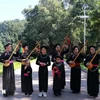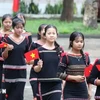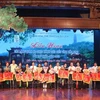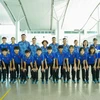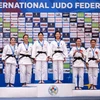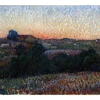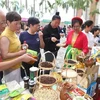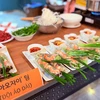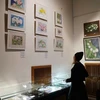Du ke, a style of musical theatre created by Khmer people in southern Vietnam in the early 1920s, is returning to the stage in its native region thanks to a handful of dedicated troupes.
"It is not a mission impossible," said Thach Muni, member of the Southwest Region Steering Committee and former manager of Anh Binh Minh, a Khmer art troupe.
"It is even easy if we follow a clear plan because Du ke has not fallen into oblivion yet. It is just at a standstill, and has not been able to keep pace with the fast modern life."
Du ke, or L'khon Ba Sac singing drama of the Ba Sac river region, was created by ethnic Khmer people in the south of Vietnam in the early 1920s, and spread widely in the region and to neighbouring Cambodia.
The south of the country has not just been blessed with natural beauty and bounty, it has also been fortunate to enjoy a rich cultural diversity that is reflected in its folk art forms.
This can be seen in the singing traditions of different ethnic communities in the region, be it cai luong and don ca tai tu of the Viet people, Tieu and Quang of the ethnic Chinese, the Ro bam and Du ke of the Khmer.
Among these, Du ke has a great advantage in comparison with others, reflecting a cultural interaction that sees one art form influenced by the other even as each retains its distinct characteristics.
Du ke has absorbed the quintessence of cai luong, Ro bam, Tieu as well as Cambodia's Di ke, Muni said.
The singing drama uses poetry based on the great Indian epics, Ramayana and the Mahabharata, he added.
Dr Pham Tiet Khanh, principal of the Tra Vinh University, said Du ke has humble roots. It does not spring from royalty but workers in the Mekong Delta.
In the early days, it was performed on land, under a simple roof. Actors were peasants turning into kings, queens and ogresses.
Some accounts say Du ke originated in Tra Vinh in 1921 by someone called Son Kuu, while others credit a person called Ly Kon in Soc Trang. But in general, it is the product of the creativity of Khmer people on either banks of the Ba Sac River.
Before 1980, there was one Du ke troupe for every two or three hamlets. They performed almost every night to entertain the Khmer people, Muni said.
From the early 1980s, the art troupes began breaking up as a result of the harsh post-war period, compounded by consecutive droughts and poor crops, pushing people's life into difficulties, said Nguyen Dai Duc, deputy director of the Tra Vinh Department of Culture, Sports and Tourism.
"Most of these troupes had been established spontaneously, and there was a lack of tight structure and complete scripts. There was also a lack of training, building adequate stage props and professionalism."
However, while amateur Du ke troupes disappeared in the 80s, there were five State-supported Khmer art troupes - Anh Binh Minh in Tra Vinh, and others in Kien Giang, Soc Trang and Bac Lieu provinces, Muni said.
He said the Khmer language television programme of Vietnam Television in the Mekong Delta region, and of radio and television stations of Tra Vinh, Soc Trang, Bac Lieu, Ca Mau, An Giang and Kien Giang provinces have done their best to preserve and promote Du ke.
In 1985, Anh Binh Minh performed Moi tinh Bopha-Rangxay (Bopha-Rangxay love affair) at the national professional theatre festival in Quy Nhon city, Binh Dinh province, and won the gold medal.
Du ke was then recognised by the Ministry of Culture and Information as a national theatre art.
The potential and possibility for reviving the somewhat dormant art form was seen over the first six months of this year when the troupe performed for a total of 97 nights at 13 communes in four districts with dominant Khmer populations, Duc said, adding the performances attracted around 44,000 people.
One interesting fact was that the troupe was able to sell double the number of tickets for performances using modern scripts as opposed to those using traditional scripts.
This showed that the quality of scripts need to be tailored to the tastes of a new audience, and that young people do seem to be attracted by "exotic culture", Duc said.
Maybe it is because many young Khmer people have already left the region for work and do not have the chance to enjoy their own art, Muni surmised.
He added that a Du ke play is about two to three hours long, and this could make it less interesting for present-day audiences.
"Writers should make it shorter so more people can enjoy the art," he said.
Khanh of the Tra Vinh University said that despite the encouraging interest in Du ke, revival of the art genre faces many challenges - scripts, actors, instrumentalists and a lack of opportunities to perform.
"The reason is that learning to acting and compose Du ke plays is not easy."
He said Du ke is a kind of "general art" that requires actors to have aptitude and knowledge of singing, dancing and acting, not to mention a good music sense.
He said that at present, the only places where Du ke can be learnt are with the troupes, which might not be the most effective way in a fast-paced modern life.
At previous conferences about preserving the ethnic Khmer culture in the south, most researchers had spoken of the need to develop a group of composers, directors, instrumentalists, actors and actress, besides focusing on writing scripts that correspond to contemporary life.
TV's role
Pham Phi Thuong, director of VTV Can Tho, said that from a professional standpoint, his station has been the main force over the past 20 years in producing Du ke plays for television.
Since 1990, the station has screened nearly 90 plays mostly by Anh Binh Minh and troupes in Soc Trang, Kien Giang and Bac Lieu
"The dramas were then shared with local televisions to meet the demand of Khmer people living in 20 districts of Mekong Delta provinces," Thuong said.
"Especially noteworthy is that several television stations of Cambodia asked permission to broadcast several Du ke plays of VTV Can Tho."
But Thuong also said that in recent years, producing Du ke dramas for television has faced many challenges.
"Its attraction has gradually faded due to the socioeconomic situation, and the profusion of modern television entertainment programmes," he said.
"And art troupes have difficulties in finding scripts, there is lack of composers and well-trained actors, and not enough investment."
Thuong said most Du ke scripts have been based on Khmer literary works and old stories with similar plots.
"Only two in the total of 90 plays were screened by VTV Can Tho that deal with modern society. The rest are all classical," he said.
"There are also scripts modified from Vietnamese language literary works and cai luong plays, but these have not made much of an impression on the audience."
Muni said several composers in the Mekong Delta have deep knowledge of the art, like Thach Chan, Ngo Khi, Son Luong, Dao Chuon, Thach So Vanh Nen and Thach Muni.
Those composers has made important contributions to developing Du ke for the last 30 years, but their number is "not enough".
Very few composers who are experimenting with modern scripts, Thuong said.
He said that in recent years, some troupes were producing "an average of two plays a year", while others did nothing.
This makes it hard for VTV Can Tho to keep producing Du ke plays under a long-term plan, he said.
However, he also asserted that Du ke can develop if it receives proper investment and clear orientation from the Government.
"In the short term, it needs to have professional training for a large number of members of amateur and professional artistic troupes, and gifted young people; and Khmer authors need to be encouraged to write Du ke scripts."
Thuong felt a periodical composing camp should be held to help script writers discuss and motivate each other to be more creative.
Tourism product
Several research reports have proposed that Du ke is developed into a tourism product as a way to preserve and promote the art.
Phan Thi Thu Hien, head of Korean Studies Faculty in the Ho Chi Minh City University of Social Sciences and Humanities, said Vietnam needs to learn from the success of other countries in bringing into play the nation's traditions.
"Korean mask dance Hahoe is a model with solutions that should be used as a reference," she said.
Hahoe, which dates back to the 12th century, had fallen into oblivion for more than 40 years before it was restored in 1973.
It is now performed as a part of traditional festivals in villages, attracting people from all over the country.
Its regular weekend performances have attracted more and more domestic and international tourists to Hahoe village, she said.
Likewise, "Du ke is performed on holidays and festivals of Khmer people including Chol Chnam Thmay, Sen Dolta and Ooc-Om-Boc. It attracts not just Khmer people, but other communities in the region," she said.
"So we can believe that Du ke has the potential and ability to succeed like the Hahoe mask dance."
Hien said Du ke is visually more attractive than Hahoe mask dance because its costumes have been influenced by the cai luong (reformed theatre) art form and by Chinese Tieu singing.
"However, to preserve and develop this art form as a tourism product, it needs to better exploit its strengths related to the legends, belief, habits and customs of Khmer pagodas and villages."
Nguyen Thi Khanh Tram, who is with the Vietnam Institute of Culture and Art Studies in Ho Chi Minh City, compared Du ke to the dance drama Barong of Bali Island in Indonesia.
She said both art forms are attractive and cannot only entertaining, but also open a window for visitors into local culture.
"If Barong is an attractive tourism product, Du ke will definitely emulate in the near future," she said.
She also suggested that stages to perform Du ke are set up at pagodas and Khmer communal sites.
"A fixed performance place is required for tourism. One performance a week at a famous pagoda will be a reasonable start," Tram said.
"It can then be increased to twice a week and then once a day as visitor interest increases."
Performances should be short, maybe the most interesting part of a story, she said.
Tram also suggested the development of Du ke plays for children as a way for younger generations to access and learn to love this art form.
All the experts agreed that a major tourism boost for Du ke would be its recognition as an intangible cultural heritage by UNESCO.-VNA
"It is not a mission impossible," said Thach Muni, member of the Southwest Region Steering Committee and former manager of Anh Binh Minh, a Khmer art troupe.
"It is even easy if we follow a clear plan because Du ke has not fallen into oblivion yet. It is just at a standstill, and has not been able to keep pace with the fast modern life."
Du ke, or L'khon Ba Sac singing drama of the Ba Sac river region, was created by ethnic Khmer people in the south of Vietnam in the early 1920s, and spread widely in the region and to neighbouring Cambodia.
The south of the country has not just been blessed with natural beauty and bounty, it has also been fortunate to enjoy a rich cultural diversity that is reflected in its folk art forms.
This can be seen in the singing traditions of different ethnic communities in the region, be it cai luong and don ca tai tu of the Viet people, Tieu and Quang of the ethnic Chinese, the Ro bam and Du ke of the Khmer.
Among these, Du ke has a great advantage in comparison with others, reflecting a cultural interaction that sees one art form influenced by the other even as each retains its distinct characteristics.
Du ke has absorbed the quintessence of cai luong, Ro bam, Tieu as well as Cambodia's Di ke, Muni said.
The singing drama uses poetry based on the great Indian epics, Ramayana and the Mahabharata, he added.
Dr Pham Tiet Khanh, principal of the Tra Vinh University, said Du ke has humble roots. It does not spring from royalty but workers in the Mekong Delta.
In the early days, it was performed on land, under a simple roof. Actors were peasants turning into kings, queens and ogresses.
Some accounts say Du ke originated in Tra Vinh in 1921 by someone called Son Kuu, while others credit a person called Ly Kon in Soc Trang. But in general, it is the product of the creativity of Khmer people on either banks of the Ba Sac River.
Before 1980, there was one Du ke troupe for every two or three hamlets. They performed almost every night to entertain the Khmer people, Muni said.
From the early 1980s, the art troupes began breaking up as a result of the harsh post-war period, compounded by consecutive droughts and poor crops, pushing people's life into difficulties, said Nguyen Dai Duc, deputy director of the Tra Vinh Department of Culture, Sports and Tourism.
"Most of these troupes had been established spontaneously, and there was a lack of tight structure and complete scripts. There was also a lack of training, building adequate stage props and professionalism."
However, while amateur Du ke troupes disappeared in the 80s, there were five State-supported Khmer art troupes - Anh Binh Minh in Tra Vinh, and others in Kien Giang, Soc Trang and Bac Lieu provinces, Muni said.
He said the Khmer language television programme of Vietnam Television in the Mekong Delta region, and of radio and television stations of Tra Vinh, Soc Trang, Bac Lieu, Ca Mau, An Giang and Kien Giang provinces have done their best to preserve and promote Du ke.
In 1985, Anh Binh Minh performed Moi tinh Bopha-Rangxay (Bopha-Rangxay love affair) at the national professional theatre festival in Quy Nhon city, Binh Dinh province, and won the gold medal.
Du ke was then recognised by the Ministry of Culture and Information as a national theatre art.
The potential and possibility for reviving the somewhat dormant art form was seen over the first six months of this year when the troupe performed for a total of 97 nights at 13 communes in four districts with dominant Khmer populations, Duc said, adding the performances attracted around 44,000 people.
One interesting fact was that the troupe was able to sell double the number of tickets for performances using modern scripts as opposed to those using traditional scripts.
This showed that the quality of scripts need to be tailored to the tastes of a new audience, and that young people do seem to be attracted by "exotic culture", Duc said.
Maybe it is because many young Khmer people have already left the region for work and do not have the chance to enjoy their own art, Muni surmised.
He added that a Du ke play is about two to three hours long, and this could make it less interesting for present-day audiences.
"Writers should make it shorter so more people can enjoy the art," he said.
Khanh of the Tra Vinh University said that despite the encouraging interest in Du ke, revival of the art genre faces many challenges - scripts, actors, instrumentalists and a lack of opportunities to perform.
"The reason is that learning to acting and compose Du ke plays is not easy."
He said Du ke is a kind of "general art" that requires actors to have aptitude and knowledge of singing, dancing and acting, not to mention a good music sense.
He said that at present, the only places where Du ke can be learnt are with the troupes, which might not be the most effective way in a fast-paced modern life.
At previous conferences about preserving the ethnic Khmer culture in the south, most researchers had spoken of the need to develop a group of composers, directors, instrumentalists, actors and actress, besides focusing on writing scripts that correspond to contemporary life.
TV's role
Pham Phi Thuong, director of VTV Can Tho, said that from a professional standpoint, his station has been the main force over the past 20 years in producing Du ke plays for television.
Since 1990, the station has screened nearly 90 plays mostly by Anh Binh Minh and troupes in Soc Trang, Kien Giang and Bac Lieu
"The dramas were then shared with local televisions to meet the demand of Khmer people living in 20 districts of Mekong Delta provinces," Thuong said.
"Especially noteworthy is that several television stations of Cambodia asked permission to broadcast several Du ke plays of VTV Can Tho."
But Thuong also said that in recent years, producing Du ke dramas for television has faced many challenges.
"Its attraction has gradually faded due to the socioeconomic situation, and the profusion of modern television entertainment programmes," he said.
"And art troupes have difficulties in finding scripts, there is lack of composers and well-trained actors, and not enough investment."
Thuong said most Du ke scripts have been based on Khmer literary works and old stories with similar plots.
"Only two in the total of 90 plays were screened by VTV Can Tho that deal with modern society. The rest are all classical," he said.
"There are also scripts modified from Vietnamese language literary works and cai luong plays, but these have not made much of an impression on the audience."
Muni said several composers in the Mekong Delta have deep knowledge of the art, like Thach Chan, Ngo Khi, Son Luong, Dao Chuon, Thach So Vanh Nen and Thach Muni.
Those composers has made important contributions to developing Du ke for the last 30 years, but their number is "not enough".
Very few composers who are experimenting with modern scripts, Thuong said.
He said that in recent years, some troupes were producing "an average of two plays a year", while others did nothing.
This makes it hard for VTV Can Tho to keep producing Du ke plays under a long-term plan, he said.
However, he also asserted that Du ke can develop if it receives proper investment and clear orientation from the Government.
"In the short term, it needs to have professional training for a large number of members of amateur and professional artistic troupes, and gifted young people; and Khmer authors need to be encouraged to write Du ke scripts."
Thuong felt a periodical composing camp should be held to help script writers discuss and motivate each other to be more creative.
Tourism product
Several research reports have proposed that Du ke is developed into a tourism product as a way to preserve and promote the art.
Phan Thi Thu Hien, head of Korean Studies Faculty in the Ho Chi Minh City University of Social Sciences and Humanities, said Vietnam needs to learn from the success of other countries in bringing into play the nation's traditions.
"Korean mask dance Hahoe is a model with solutions that should be used as a reference," she said.
Hahoe, which dates back to the 12th century, had fallen into oblivion for more than 40 years before it was restored in 1973.
It is now performed as a part of traditional festivals in villages, attracting people from all over the country.
Its regular weekend performances have attracted more and more domestic and international tourists to Hahoe village, she said.
Likewise, "Du ke is performed on holidays and festivals of Khmer people including Chol Chnam Thmay, Sen Dolta and Ooc-Om-Boc. It attracts not just Khmer people, but other communities in the region," she said.
"So we can believe that Du ke has the potential and ability to succeed like the Hahoe mask dance."
Hien said Du ke is visually more attractive than Hahoe mask dance because its costumes have been influenced by the cai luong (reformed theatre) art form and by Chinese Tieu singing.
"However, to preserve and develop this art form as a tourism product, it needs to better exploit its strengths related to the legends, belief, habits and customs of Khmer pagodas and villages."
Nguyen Thi Khanh Tram, who is with the Vietnam Institute of Culture and Art Studies in Ho Chi Minh City, compared Du ke to the dance drama Barong of Bali Island in Indonesia.
She said both art forms are attractive and cannot only entertaining, but also open a window for visitors into local culture.
"If Barong is an attractive tourism product, Du ke will definitely emulate in the near future," she said.
She also suggested that stages to perform Du ke are set up at pagodas and Khmer communal sites.
"A fixed performance place is required for tourism. One performance a week at a famous pagoda will be a reasonable start," Tram said.
"It can then be increased to twice a week and then once a day as visitor interest increases."
Performances should be short, maybe the most interesting part of a story, she said.
Tram also suggested the development of Du ke plays for children as a way for younger generations to access and learn to love this art form.
All the experts agreed that a major tourism boost for Du ke would be its recognition as an intangible cultural heritage by UNESCO.-VNA
